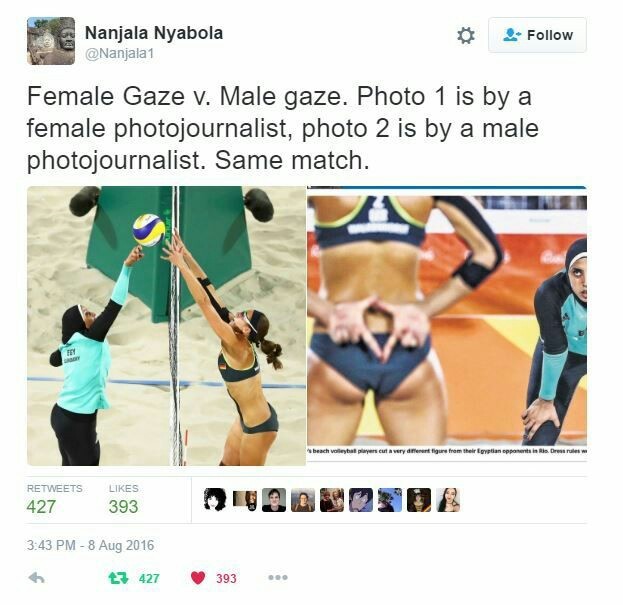The male gaze was first coined by Laura Mulvey (1999) contributing its development to the media. In this she notes that women are exhibited and constantly looked at. Women are displayed in order to demonstrate a visual and erotic impact as if all women want to be looked as a solely sexual being. In essence the male gaze is a slow up and down gape or even a focused stare at a sexualized body part, which objectifies women and positions men as the subject of the gaze.
The media has been credited as creating women as a spectacle for their sexual attractiveness. The media portrays women for the male viewing of the women’s body. In other words media outlets are feeding sexual objectifications of women to the public for male pleasure. This entails that other facets of viewing women are sexualized. Men begin to think (or have always thought) that women are solely there for their (male) sexual pleasure.

Advertising has shown a shift in the portrayal of women. Women were and in some campaigns still are, presented as if they are here for male pleasure. Yet currently advertising campaigns have changed the narrative of the female model to: I am here for my own pleasure (Gill, 2008). Adding to this, some feminists argue that the adverts of sexual empowerment and what it means to be beautiful are still harmful to women. The image of an all rounded beautiful women has the reality of women taking part in harmful activities to reach the standard of beauty (Bordo, 1995; Coward, 1984; Kilbourne, 1999). While other feminists argue that woman should embrace their sexuality and it is their choice to fit into the beauty ideal (Jervis & Ziesler, 2006).
Sexual objectification, the way in which the female body is viewed as an object only deemed purposeful for the male sexual interaction (Mulvey, 1999), I hope you know, that this may present negative emotional and mental consequences for the female (Fredrickson & Roberts, 1997). What happens through this sexual objectification is that men objectify the women’s body. If the body fulfils certain requirements it is “HOT”. When women realise they are not fitting into this they end up self objectifying themselves, essentially pointing out all the things they don’t like about their bodies as it does not fit into the category of ‘HOT” (Fredrickson & Roberts, 1997).
Women may end up body shaming themselves, developing eating disorders, having anxiety about how they look, constantly surveying themselves as to fit into this norm (where they think they need to belong). They may not perform as well mentally as they could have if they were taught/thought/or even told that they were beautiful enough (Calogero, 2004).
As a young female I personally experience the male gaze. When I found out the male gaze was actually what I was referring to during the development of this blog I realised that I am not the only one who experiences this gaze and who doesn’t want to be part of it.
Personally the male gaze has created useless anxiety about how to dress my body, for example when to wear no sleeves and when to wear them. By being visible to the male gaze it exerts power over me. This means that the male gaze is a form of discipline over my body. In turn this discipline forces me to correct/change my behaviour, in this case what I wear, in order to avoid the gazes. According to Foucault, this is how visibility is a source of discipline and control (1977). If I avoid the gazes I won’t feel uncomfortable, but I won’t be confident in how I dress myself. If I dress confidently and get gazed at I am punished through the uncomfortable feelings generated through the gazes and next time will work eagerly to avoid those anxieties, in so controlling my behaviour.
The male gaze has also made me doubtful of myself; you would think that maybe getting a look here and there from someone other than your partner would boost your morale, but no. What happens is that I start to think “are they really looking at me or is this all built up in my head?” Maybe that guy at the Spar just saw a really good deal and he can’t read from a distance so unfortunately I was just in the way. Maybe that same “Spar guy” who waved at me in the traffic is getting me confused with someone else. Maybe he is not a stalker and maybe the rape-y vibes he gives off is just me being delusional.
I do not like being sexually objectified; I do not like doubting the way I dress myself. So many women have suffered psychologically and physically from the male gaze and the overall sexual objectification of our bodies. It is extremely unfortunate that my own experience of objectification isn’t the first and will not be the last.
By Cassandra Robertson
References
Calogero, R.M. (2004). A test of objectification theory: the effect of the male gaze on appearance concerns in college women. Psychology Women Quarterly (28), 16-21 DOI: 10.1111/j.1471-6402.2004.00118.x
Foucault, M. (1977). Discipline and Punish: the birth of the prison. NY: Vintage Books.
Fredrickson, B. L., & Roberts, T. (1997). Objectification theory: toward understanding women’s lived experiences and mental health risks. Psychology of Women Quarterly, (21), 173–206
Gill, R. 2008. Culture and subjectivity in neoliberal and post femininst time. Subjectivity, (25), 432-445. DOI 101.1057/sub2008.28
Mulvey, L. (1999). Visual Pleasure and Narrative Cinema.In L.Braudy and M.Cohen (Eds.), Film Theory and Criticism:Introductory Readings (pp.57-69). NY: Oxford UP
